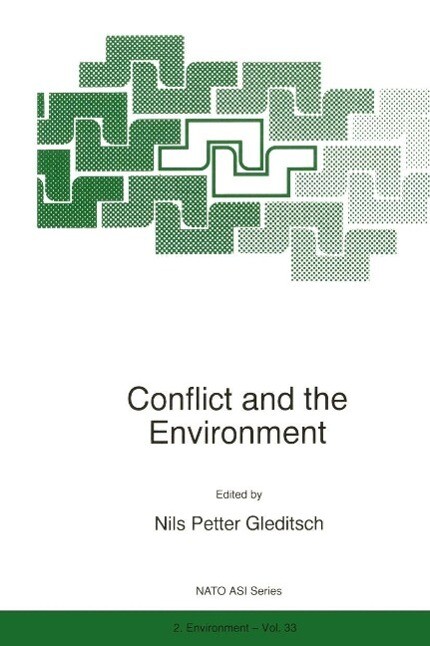
Sofort lieferbar (Download)
Nils Petter Gleditsch International Peace Research Institute, Oslo (PRIO) & Department of Sociology and Political Science, Norwegian University of Science and Technology, Trond heim This book could hardly have happened but for the end of the Cold War. The decline of the East-West conflict has opened up the arena for increased attention to other lines of conflict, in Europe and at the global level. Environmental disruption, not a new phenomenon by any means, is a chief beneficiary of the shift in priorities in the public debate. The Scientific and Environmental Affairs Divi sion of NATO has moved with the times and has defined environmental security as one of its priority areas for cooperation with Central and Eastern Europe and countries of the former Soviet Union. This book is the main output of an Advanced Research Workshop (ARW), held in Bolkesjl/l, Norway, 12-16 June 1996. I would like to acknowledge the personal support of L. Veiga da Cunha, Director of the Priority Area on Environmental Security. Research on these issues is now very much a collaborative effort across former lines of division in Europe. NATO encourages, indeed requires, that this be reflected in the composition of the participants, as well as the organizing committee. This meeting was organized by a group of five people from five different countries: Lothar Brock (Germany), Nils Petter Gleditsch (Norway), Thomas Homer-Dixon (Canada), Renat Perelet (Co-Director, Russia), and Evan Vlachos (USA).
Inhaltsverzeichnis
1. Our Future Common, or None at All. - A. Environmental Security? . - 2. The Environment and Security: Conceptual and Theoretical Issues. - 3. Environmental Conflict and Environmental Determinism: The Relative Importance of Social and Natural Factors. - 4. Environmental Conflict: A Values-oriented Approach. - 5. Rethinking Environmental Security. - 6. Environmental Conflict and the Democratic Peace. - B. Environmental Degradation. - 7. Conflicts and Environmental Change: Models and Methods. - 8. Military Conflict and Mineral Supplies: Results Relevant to Wider Resource Issues. - 9. Environmental Conflicts in Africa. - 10. China: Environmental Stress and Violent Conflict. - Chaper 11. Threats to Security: Environmental Degradation in the Former Soviet Union. - 12. Environmental Ethics and Conflicting Ethnicity: A Value-oriented Analysis. - 13. Environment and Security: Property and Regional Problems in Arkhangelsk. - C. Fisheries Conflicts. - 14. States, Stocks, and Sovereignty: High Seas Fishing and the Expansion of State Sovereignty. - 15. The Turbot War: Resolution of an International Fishery Dispute. - D. Environmental Refugees. - 16. Environmental Degradation, Migration, and the Potential for Violent Conflict. - 17. In Limbo: Environmental Refugees in the Third World. - 18. Environmental Refugees: The Growing Challenge. - E. Water Conflicts. - 19. Transboundary Issues in Water Resources. - 20. Transboundary Water Resources in the Iberian Peninsula. - 21. Water and Armed Conflict in the Middle East Fantasy or Reality? . - 22. Water Resources and Conflict: Examples from the Middle East. - 23. Integrating Political and Technical Approaches: Lessons from the Israeli Jordanian Water Negotiations. - 24. Sharing International Rivers: A Regional Approach. - 25. The `Aral Sea Syndrome andRegional Cooperation in Central Asia: Opportunity or Obstacle? . - 26. Water Management in the Seversky Donets River: A Challenge for the Near Future. - 27. The Wetlands of Ukraine: The National Economy vs. the Environment. - F. Responses. - 28. Sustainable Defence: A Conceptual Model. - 29. Environmental Security and Instrument Choice. - 30. Pre-empting Violent Conflict: Learning from Environmental Cooperation. - 31. Environmental Conflict and International Integration. - 32. Environmental Protection from Wartime Damage: The Role of International Law. - 33. International Environmental Justice. - 34. The Environmental Code and Conflict Resolution. - G Epilogue. - 35. Report on the Proceedings. - Name Index.
Produktdetails
Erscheinungsdatum
17. April 2013
Sprache
englisch
Auflage
1997
Seitenanzahl
598
Dateigröße
66,80 MB
Reihe
NATO Science Partnership Subseries: 2
Herausgegeben von
N. P. Gleditsch
Verlag/Hersteller
Kopierschutz
mit Wasserzeichen versehen
Produktart
EBOOK
Dateiformat
PDF
ISBN
9789401589475
Entdecken Sie mehr
Bewertungen
0 Bewertungen
Es wurden noch keine Bewertungen abgegeben. Schreiben Sie die erste Bewertung zu "Conflict and the Environment" und helfen Sie damit anderen bei der Kaufentscheidung.










